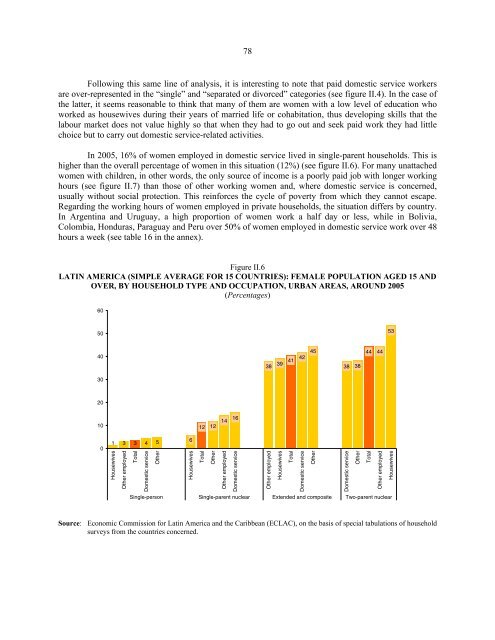Women in Latin America and the Caribbean - Cepal
Women in Latin America and the Caribbean - Cepal
Women in Latin America and the Caribbean - Cepal
Create successful ePaper yourself
Turn your PDF publications into a flip-book with our unique Google optimized e-Paper software.
78<br />
Follow<strong>in</strong>g this same l<strong>in</strong>e of analysis, it is <strong>in</strong>terest<strong>in</strong>g to note that paid domestic service workers<br />
are over-represented <strong>in</strong> <strong>the</strong> “s<strong>in</strong>gle” <strong>and</strong> “separated or divorced” categories (see figure II.4). In <strong>the</strong> case of<br />
<strong>the</strong> latter, it seems reasonable to th<strong>in</strong>k that many of <strong>the</strong>m are women with a low level of education who<br />
worked as housewives dur<strong>in</strong>g <strong>the</strong>ir years of married life or cohabitation, thus develop<strong>in</strong>g skills that <strong>the</strong><br />
labour market does not value highly so that when <strong>the</strong>y had to go out <strong>and</strong> seek paid work <strong>the</strong>y had little<br />
choice but to carry out domestic service-related activities.<br />
In 2005, 16% of women employed <strong>in</strong> domestic service lived <strong>in</strong> s<strong>in</strong>gle-parent households. This is<br />
higher than <strong>the</strong> overall percentage of women <strong>in</strong> this situation (12%) (see figure II.6). For many unattached<br />
women with children, <strong>in</strong> o<strong>the</strong>r words, <strong>the</strong> only source of <strong>in</strong>come is a poorly paid job with longer work<strong>in</strong>g<br />
hours (see figure II.7) than those of o<strong>the</strong>r work<strong>in</strong>g women <strong>and</strong>, where domestic service is concerned,<br />
usually without social protection. This re<strong>in</strong>forces <strong>the</strong> cycle of poverty from which <strong>the</strong>y cannot escape.<br />
Regard<strong>in</strong>g <strong>the</strong> work<strong>in</strong>g hours of women employed <strong>in</strong> private households, <strong>the</strong> situation differs by country.<br />
In Argent<strong>in</strong>a <strong>and</strong> Uruguay, a high proportion of women work a half day or less, while <strong>in</strong> Bolivia,<br />
Colombia, Honduras, Paraguay <strong>and</strong> Peru over 50% of women employed <strong>in</strong> domestic service work over 48<br />
hours a week (see table 16 <strong>in</strong> <strong>the</strong> annex).<br />
Figure II.6<br />
LATIN AMERICA (SIMPLE AVERAGE FOR 15 COUNTRIES): FEMALE POPULATION AGED 15 AND<br />
OVER, BY HOUSEHOLD TYPE AND OCCUPATION, URBAN AREAS, AROUND 2005<br />
(Percentages)<br />
60<br />
50<br />
53<br />
40<br />
30<br />
20<br />
10<br />
12<br />
12 14 16 38 39 41 42 45<br />
38 38<br />
44 44<br />
0<br />
1<br />
Housewives<br />
3<br />
O<strong>the</strong>r employed<br />
3<br />
Total<br />
4<br />
Domestic service<br />
5<br />
O<strong>the</strong>r<br />
6<br />
Housewives<br />
Total<br />
O<strong>the</strong>r<br />
O<strong>the</strong>r employed<br />
Domestic service<br />
O<strong>the</strong>r employed<br />
Housewives<br />
Total<br />
Domestic service<br />
O<strong>the</strong>r<br />
Domestic service<br />
O<strong>the</strong>r<br />
Total<br />
O<strong>the</strong>r employed<br />
Housewives<br />
S<strong>in</strong>gle-person S<strong>in</strong>gle-parent nuclear Extended <strong>and</strong> composite Two-parent nuclear<br />
Source: Economic Commission for Lat<strong>in</strong> <strong>America</strong> <strong>and</strong> <strong>the</strong> <strong>Caribbean</strong> (ECLAC), on <strong>the</strong> basis of special tabulations of household<br />
surveys from <strong>the</strong> countries concerned.











